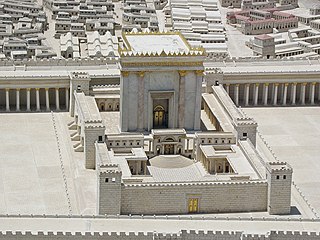Siege of Jerusalem, fall of Jerusalem, or sack of Jerusalem may refer to:

The Kingdom of Judah was an Israelite kingdom of the Southern Levant during the Iron Age. Centered in the highlands to the west of the Dead Sea, the kingdom's capital was Jerusalem. It was ruled by the Davidic line for four centuries. Jews are named after Judah, and primarily descend from people who lived in the region.

The Maccabees, also spelled Machabees, were a group of Jewish rebel warriors who took control of Judea, which at the time was part of the Seleucid Empire. Its leaders, the Hasmoneans, founded the Hasmonean dynasty, which ruled from 167 BCE to 37 BCE, being a fully independent kingdom from 104 to 63 BCE. They reasserted the Jewish religion, expanded the boundaries of Judea by conquest, and reduced the influence of Hellenism and Hellenistic Judaism.

The Hasmonean dynasty was a ruling dynasty of Judea and surrounding regions during the Hellenistic times of the Second Temple period, from c. 140 BCE to 37 BCE. Between c. 140 and c. 116 BCE the dynasty ruled Judea semi-autonomously in the Seleucid Empire, and from roughly 110 BCE, with the empire disintegrating, Judea gained further autonomy and expanded into the neighboring regions of Perea, Samaria, Idumea, Galilee, and Iturea. The Hasmonean rulers took the Greek title basileus ("king") as the kingdom became a regional power for several decades. Forces of the Roman Republic intervened in the Hasmonean Civil War in 63 BCE and made it into a client state, marking the decline of Hasmonean dynasty; Herod the Great displaced the last reigning Hasmonean client-ruler in 37 BCE.

This is a timeline of major events in the history of Jerusalem; a city that had been fought over sixteen times in its history. During its long history, Jerusalem has been destroyed twice, besieged 23 times, attacked 52 times, and captured and recaptured 44 times.

Judas Maccabaeus or Maccabeus, also known as Judah Maccabee, was a Jewish priest (kohen) and a son of the priest Mattathias. He led the Maccabean Revolt against the Seleucid Empire.

John Hyrcanus was a Hasmonean (Maccabean) leader and Jewish High Priest of Israel of the 2nd century BCE. In rabbinic literature he is often referred to as Yoḥanan Cohen Gadol, "John the High Priest".

Aristobulus II was the Jewish High Priest and King of Judea, 66 BCE to 63 BCE, from the Hasmonean dynasty.

John Hyrcanus II, a member of the Hasmonean dynasty, was for a long time the Jewish High Priest in the 1st century BCE. He was also briefly King of Judea 67–66 BCE and then the ethnarch (ruler) of Judea, probably over the period 47–40 BCE.
The history of the Jews and Judaism in the Land of Israel begins in the 2nd millennium BCE, when Israelites emerged as an outgrowth of southern Canaanites. During biblical times, a postulated United Kingdom of Israel existed but then split into two Israelite kingdoms occupying the highland zone: the Kingdom of Israel (Samaria) in the north, and the Kingdom of Judah in the south. The Kingdom of Israel was conquered by the Neo-Assyrian Empire, and the Kingdom of Judah by the Neo-Babylonian Empire. Initially exiled to Babylon, upon the defeat of the Neo-Babylonian Empire by the Achaemenid Empire under Cyrus the Great, many of the Jewish exiles returned to Jerusalem, building the Second Temple.

The Battle of the Ascent of Lebonah or Battle with Apollonius was the first battle fought between the Maccabees and the Seleucid Empire in 167 or 166 BCE. The Jewish forces were led by Judas Maccabeus and the Seleucid army force was under the command of Apollonius, described by Josephus as "the strategos (general) of the Samaritan forces".

The Maccabean Revolt was a Jewish rebellion led by the Maccabees against the Seleucid Empire and against Hellenistic influence on Jewish life. The main phase of the revolt lasted from 167 to 160 BCE and ended with the Seleucids in control of Judea, but conflict between the Maccabees, Hellenized Jews, and the Seleucids continued until 134 BCE, with the Maccabees eventually attaining independence.
Jewish military history focuses on the military aspect of history of the Jewish people from ancient times until the modern age.

Hasmonean coinage are the coins minted by the Hasmonean kings. Only bronze coins in various denominations have been found; the smallest being a prutah or a half prutah. Two Roman silver denarii are associated with the Hasmoneans; one has the inscription BACCIVS IVDAEAS; with its exact meaning unclear (short for "BASILEOS IUDAEAS", King Judas?). Both show a man thought to be Yehuda Aristobolus bowing before a camel with a palm branch in his hand.

The Second Temple period or post-exilic period in Jewish history denotes the approximately 600 years during which the Second Temple stood in the city of Jerusalem. It began with the return to Zion and subsequent reconstruction of the Temple in Jerusalem, and ended with the First Jewish–Roman War and the Roman siege of Jerusalem.

Judea or Judaea is a mountainous region of the Levant. Traditionally dominated by the city of Jerusalem, it is now part of Palestine and Israel. The name's usage is historic, having been used in antiquity and still into the present day; it originates from Yehudah, a Hebrew name. Yehudah was a son of Jacob, who was later given the name "Israel" and whose sons collectively headed the Twelve Tribes of Israel. Yehudah's progeny among the Israelites formed the Tribe of Judah, with whom the Kingdom of Judah is associated. Related nomenclature continued to be used under the rule of the Babylonians, the Persians, the Greeks, and the Romans. Under the Hasmoneans, the Herodians, and the Romans, the term was applied to an area larger than Judea of earlier periods. In 132 CE, the Roman province of Judaea was merged with Galilee to form the enlarged province of Syria Palaestina.
The Ptolemaic Baris was a citadel maintained by Ptolemaic Egypt during its rule of Jerusalem in the 3rd century BC. Described by only a few ancient sources, no archaeological remains of the citadel have been found and much about it remains a matter of conjecture.
The timeline of the Palestine region is a timeline of major events in the history of Palestine. For more details on the history of Palestine see History of Palestine. In cases where the year or month is uncertain, it is marked with a slash, for example 636/7 and January/February.
Hellenistic Palestine is the term for historic Palestine during the Hellenistic period, when Achaemenid Syria was conquered by Alexander the Great in 333 BCE and subsumed into his growing Macedonian empire. After his death in 323 BCE, Alexander's empire was divided among his generals, the Diadochi, marking the beginning of Macedonian rule over various territories, including Coele-Syria. The region came under Ptolemaic rule beginning when Ptolemy I Soter took control of Egypt in 322 BCE and subsequently Yehud Medinata in 320 BCE due to its strategic significance. This period saw numerous conflicts as former generals vied for control, leading to ongoing power struggles and territorial exchanges.

The Second Temple period in Jewish history began with the end of the Babylonian captivity and the Persian conquest of the Babylonian Empire in 539 BCE. A new temple to replace the destroyed Solomon's Temple was built in Jerusalem by the returnees, and the Second Temple was finished around 516 BCE. Second Temple Judaism was centered around the religious leadership of the Second Temple, and lasted for six centuries. The Persians were largely tolerant of Judaism. Persian rule lasted for two centuries, but came to an end with the conquests of Macedonia under Alexander the Great in 332 BCE. Judea and the Eastern Mediterranean region came under Greek influence during the resulting Hellenistic period; Hellenistic Judaism blended both Greek and Jewish traditions. Judea was ruled in this period first by the Ptolemaic Kingdom and then by the Seleucid Empire, Greek states formed after the breakup of Alexander's Macedonian empire. The Maccabean Revolt of 167–142 BCE was initially a fight for Judean autonomy against a suppression of traditional Judaism by Seleucid King Antiochus IV, and later sought outright independence from Greek rule. The revolt's success brought about the formation of an independent Hasmonean kingdom of Judea, named for the family which had led the Jewish resistance.